When presenting one's work, it is natural to think in terms of the horizontal frame as this is more or less the way we see the world (through two eyes with one eye horizontal to the other); cameras furthermore, are designed to photograph horizontally although one is able to move the camera into the vertical position and make photographs with no technical impediment. The vertical frame is a little more unusual yet since vertical is often the preferred format for media such as magazines and books, vertically designed images are worthwhile making. It is something of a luxury to be able to contribute to a book where images are printed horizontally across the page.
When designing for the vertical or horizontal format, it is worth considering the way the commonly used proportions relate to each other; the diagram below shows different sizes and proportions together ...
In the diagram, blue is A4 while red is 10by8, the traditional portrait size.
When designing for the vertical or horizontal format, it is worth considering the way the commonly used proportions relate to each other; the diagram below shows different sizes and proportions together ...
In the diagram, blue is A4 while red is 10by8, the traditional portrait size.
The green frames are the 2by3 camera proportions shown in relation to both A4 and 10by8 sizes of paper; they fit quite well but if the page needed to be filled, part of the image would be lost along the top and the bottom.
If printed full frame then there would be some space between the photograph and the edge of the frame, along the sides but unlikely to be enough for a body of text in the vertical format.


No comments:
Post a Comment